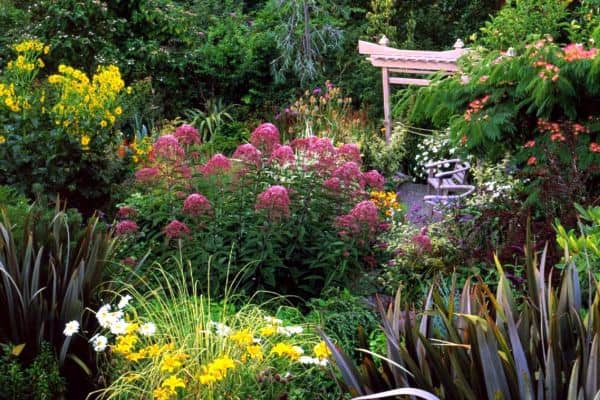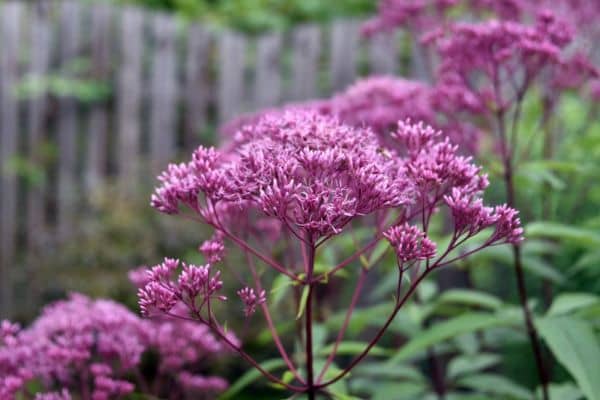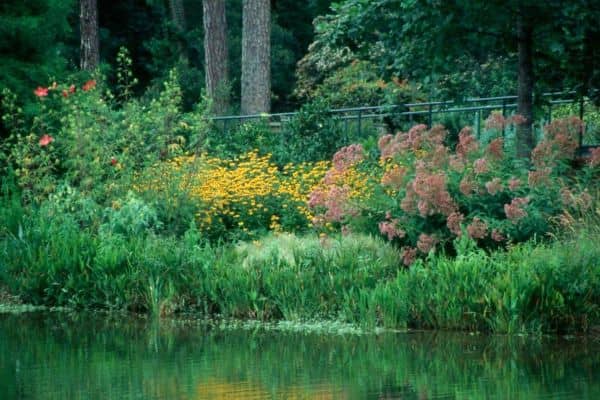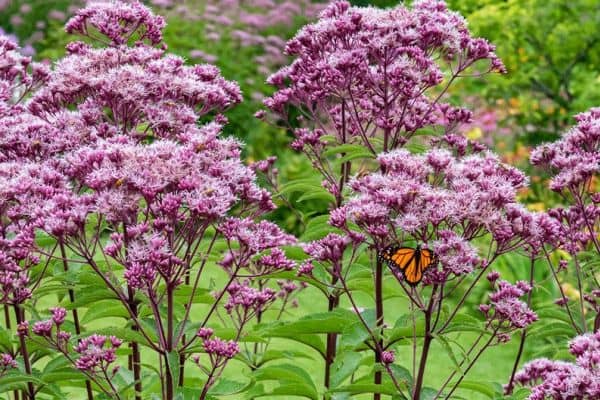Joe Pye Weed is a low-maintenance plant that is native to eastern and central North America, from Ontario east to Louisiana, Oklahoma, New Hampshire, and south as far as Florida. They are also known as boneset, thoroughwort, and snakeroot.
If you want to grow and take care of the Joe Pye Weed in your garden here are some of the ways you can grow and take care of your Joe Pye Weed with its types and companion plants:
How to Grow Joe Pye Weed
So you have made up your mind to grow Joe Pye Weed but don’t know where to start just know it is one of the carefree plants. All you have to do is keep the seedlings moist for about a year until they get well-established. After they have well-established they can even survive in the dry season but don’t forget to water them in a hot weather week or if it hasn’t rained.
If you have planted Joe Pye Weeds in the woods or a meadow then you will not have to worry about them but if the soil quality is poor you can just add some slow-release fertilizer or side dressing of compost they will be fine with it. Just remember to use fertilizer or side dressing of compost in early spring as they are sending up new shoots at that season.

How to Care Joe Pye Weed
Joe Pye weed is one of the well-known plants for being low-maintenance still you will have to take care of it. So here are some of the list to mainly take care of Joe Pye weed:
- You will have to leave them plenty of space to accommodate their height and spread.
- Don’t forget to water them well as they need water.
- You can also apply fertilizer to your garden soil that has poor quality.
- If the plant grows too heavy when its flower blooms you will have to stake the plant.
Light
Joe Pye weed plants can be grown in both full sun and partial shade but too much shade can cause them to have legginess and cause the plant to flop over. Also, remember that shady conditions can make the plant susceptible to disease and too much strong sun can cause yellowing of the leaves.
You will also have to save Joe Pye weed plants during the summer months from the hot afternoon sun.
Soil
Talking about soil for Joe Pye weed plants they can tolerate nearly all soil pH levels and are adaptable to different soil conditions. But for better growth, they need fairly rich, well-drained soil.
Water
Water is also important for the better growth of the Joe Pye weed plants as they need their soil moisture for proper growth. Just remember not to keep it soggy and water them during hot weather. You can also use mulch around them to keep soil moisture and tp keep the roots cool.
Temperature and Humidity
Joe Pye weed can survive in any harsh condition most of the time where it is hot or cold. But the frost will cause Joe Pye weed to die but will regrow in most of the cases. As for humidity, they won’t have any issues as long as the soil is moist.
Fertilizer
So if Joe Pye weed is native to your areas you will not have to think about using fertilizer for them. But if your area is not native or has poor soil quality then you will have to use fertilizer which should be a slow-release granule fertilizer formulated for flowering plants in the spring. After using fertilizer in spring you can also use fertilizer again in the midsummer when blooms begin to appear. You can also use the composite by mixing the with soil or using them around the plant soil.

Types of Joe Pye Weed
There are a lot of varieties of Joe Pye weed but all of them are extremely similar in appearance and can be distinguished by color and their flower blooming season. Most of the local gardens or nurseries sell “Joe Pye Weed” (Eutrochium) to their customers. So here are some of the various species of Joe Pye Weed:
1. Eutrochium purpureum: Eutrochium purpureum is a central and eastern United States native species that has solid green stems with beautiful purple leaves. They can grow up to 7 feet tall and their beautiful clusters of tiny mauve flowers appear in mid- to late summer.
2. Eutrochium maculatum: Eutrochium maculatum is a beautiful Joe Pye Weed variety that has purple-speckled stems with light to dark purple colored flowers. They also have several names within their species and they bred for resistance to powdery mildew.
3. Eutrochium dubium: This species sometimes has purple stems and features dark purple blooms. The East Coast native grows to about 5 1/2 feet tall. The flowers are an attractive pink-purple.
4. Eutrochium fistulosum: Eutrochium fistulosum attracts a lot of birds as they love to feed on their prolific seed heads. They have Green stems with muted pink-purple colored flowers
5. Eutrochium steelei: Eutrochium steelei has greenish-purple stems and pink or purple flowers. But the native Appalachian mountain species have greenish-purple stems and grow up to 6 to 7 feet tall.

Joe Pye Weed Companion Plants
So you have grown Joe Pye weed successfully but want to plant some companion plants for them as you can use late summer/fall bloomers or larger growing ones to match its size. So here are some of the list for the Joe Pye weed companion:
Ornamental Grasses for Joe Pye Weed Companion
- Andropogon (Big Bluestem)
- Miscanthus (Chinese Maiden Hair grass)
- Sporobolus wrightii ‘Windbreaker’ (Giant Sacaton grass)
- Sporobolus heterolepis (Prairie Dropseed grass)
- Muhlenbergia capillaris (Coast Muhly)
- Panicum (Prairie Switchgrass)
Flowering Plants for Joe Pye Weed Companion
- Asclepias incarnata (Swamp Milkweed)
- Aster (Aster)
- Coreopsis triperis ‘Gold Standard’
- Echinacea (Coneflower)
- Monarda (Beebalm)
- Phlox paniculata (Garden Phlox)
- Physostegia (Obedient Plant)
FAQs
Q. Is Joe Pye Weed Invasive?
No, Joe Pye weed is not an invasive plant as it is native to North America. But they spread quickly in gardens and escape to surrounding areas through roos and by casting seeds.
Q. Where does Joe Pye Weed Grow Best?
Joe Pye weed grows best in its native areas but it can also be grown in non-native areas as long as you can fulfill its requirements like water, soil needs, fertilizers, sun, and temperature.
Q. What Can I Plant Next to Joe Pye Weed?
You can plant different types of late summer/fall bloomers like Andropogon (Big Bluestem), Asclepias incarnata (Swamp Milkweed), Sporobolus wrightii ‘Windbreaker’ (Giant Sacaton grass), Coreopsis triperis ‘Gold Standard’, Muhlenbergia capillaris (Coast Muhly), Phlox paniculata (Garden Phlox), and many more.
Also Read: All You Need To Know About Polka Dot Plants – Growth, Care, Tips, and More
